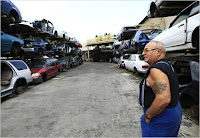CO2 emissions savings:
Assuming that driving habits do not change, this program will probably reduce carbon dioxide (CO2) emissions in the future, but will raise the emissions in the short term. Building new cars take energy. Seikei University estimated that 12 percent of the CO2 use during the life of a car was pre-purchase. Toyota found that this can be as high as 28 percent. Volvo will be building the first carbon dioxide free manufacturing plant for their trucks, but even then, the trunks need to be moved to their point of sale.
All these studies have a problem. They are measuring the presale CO2 use as a percent of vehicle’s total life use. A better measure is tons of carbon dioxide per vehicle. A rough estimate of the pounds of CO2 used in manufacturing is 2.5 times the weight of the vehicle. So, a Prius weighing 2,890 pounds would use 7,200 pounds, and a Durango weighing 6,600 pounds would use 17,000 pounds. Another figure I have read is 14,000 pounds average.
http://www.fueleconomy.gov/Feg/co2.shtml calculates 20 pounds of CO2 are released from burning a gallon of gas. For simplicity I will use EPA fuel ratings for cars.
Let G = gallons, M = miles, and lbs = pounds,
G/M * lbs/M = lbs/M
To simplify this, to get the CO2 in lbs release per mile, divide 20 by the MPG.
EPA rates the most efficient 1999 Dodge Durango at 13 MPG combined. This gives us 20/13 lbs carbon dioxide per mile. (About 1.538 lbs/mile)

EPA rates the 2009 Toyota Prius at 46 MPG combined. That gives us 20/46 lbs/mile (about 0.434 lbs/mile).

Trading in a 1999 Durango for a 2009 Prius save 1.104 lbs/mile of carbon dioxide. With a presale CO2 emission of 7,200 lbs, every mile after 6,522 miles saves CO2 emissions. If this was close to what we could expect from this program I would support it without issue.
The new regulations require an SUV to get at least two MPG better, and the old one must get less than 15 MPG. So, what happens if the 1999 Durango is traded in on a 2009 Durango. The 2009 Durango has an EPA rating of 16 MPG combined, or 1.25 lbs/mile. Now the savings are 0.288 lbs/mile. With a presale emission of 17,000 lbs it will take 59,028 miles to break even on CO2 emissions.
Assuming 15,000 miles per year average driving, we are trading increased CO2 emissions today for saving 4 years from now. But, the trade-in car most have been used for only one year, and the car must be crushed or shredded. A one year old car, a barely used car that emitted 17,000 pounds of CO2 presale is being crushed and another 17,000 pounds of CO2 are being emitted. Rounding 59,028 to 60,000, and allowing for the 15,000 miles on the trade-in, it will take 105,000 miles before there is any CO2 savings.
So, who will take advantage of this law? I claim that the majority of people will be those with late model cars and trucks that can afford, even in a recession to purchase a new vehicle. Thus the predominance of trade-ins will be those that minimize the CO2 emissions savings.
This is not a "green" law, it is another auto industry bailout law.
Car Collectors:
The cash for clunkers law requires that the trade-in be crushed or shredded. In this case the one year old Dodge is not my concern, but rather the cars from the 1980's and earlier. By definition these are vintage cars, and in practice people are buying them and using them as vintage cars.

If these cars are in good running and good body condition, a collector would probably want it. Unfortunately if traded in they will be destroyed. Suppose the car is in poor running and body condition. It is a parts car. And that is the problem. Vintage auto owners need parts to maintain their cars.

Impact on lower income people:
First, lower income car owners use wrecking yards or parts cars to maintain their vehicles. Crushing trade-ins reduces the supply of used parts. This will raise the price of used parts, or in some cases make used parts completely unavailable.

This program requires the person taking advantage of it to have the income to purchase a new car. Normally each new car purchased adds a used car to the market. Thus the more new cars sold the greater the supply of used cars, and the lower the prices. But, this program insures that the used cars are crushed, maximizing the price of used cars.
Summary:
The cash for clunkers is in fact cash for late model used cars. The beneficiaries are the auto industry and those that can afford a new car without this program. It is being paid for by tax payer, and especially by car collectors and lower income car owners.
No comments:
Post a Comment